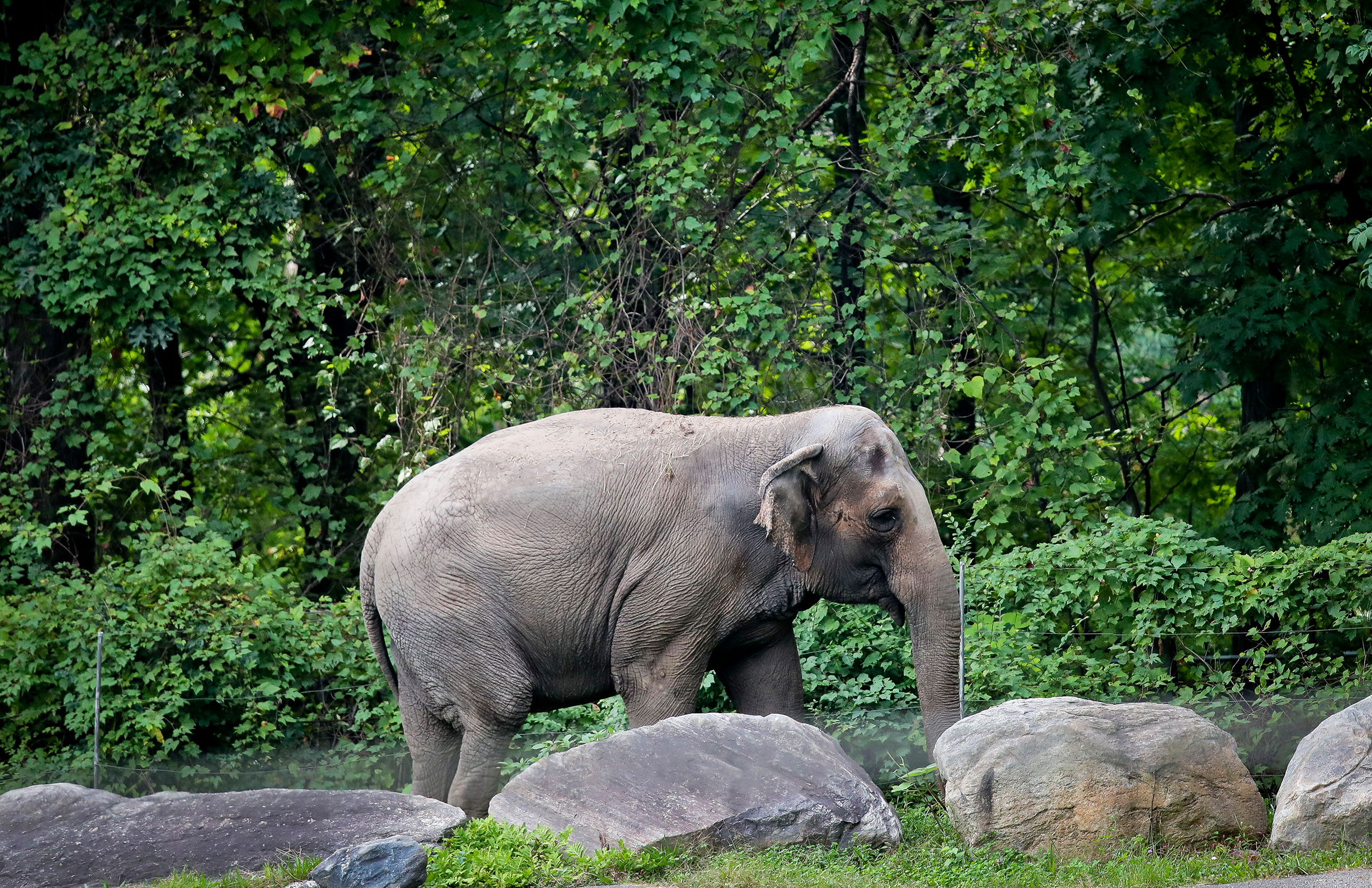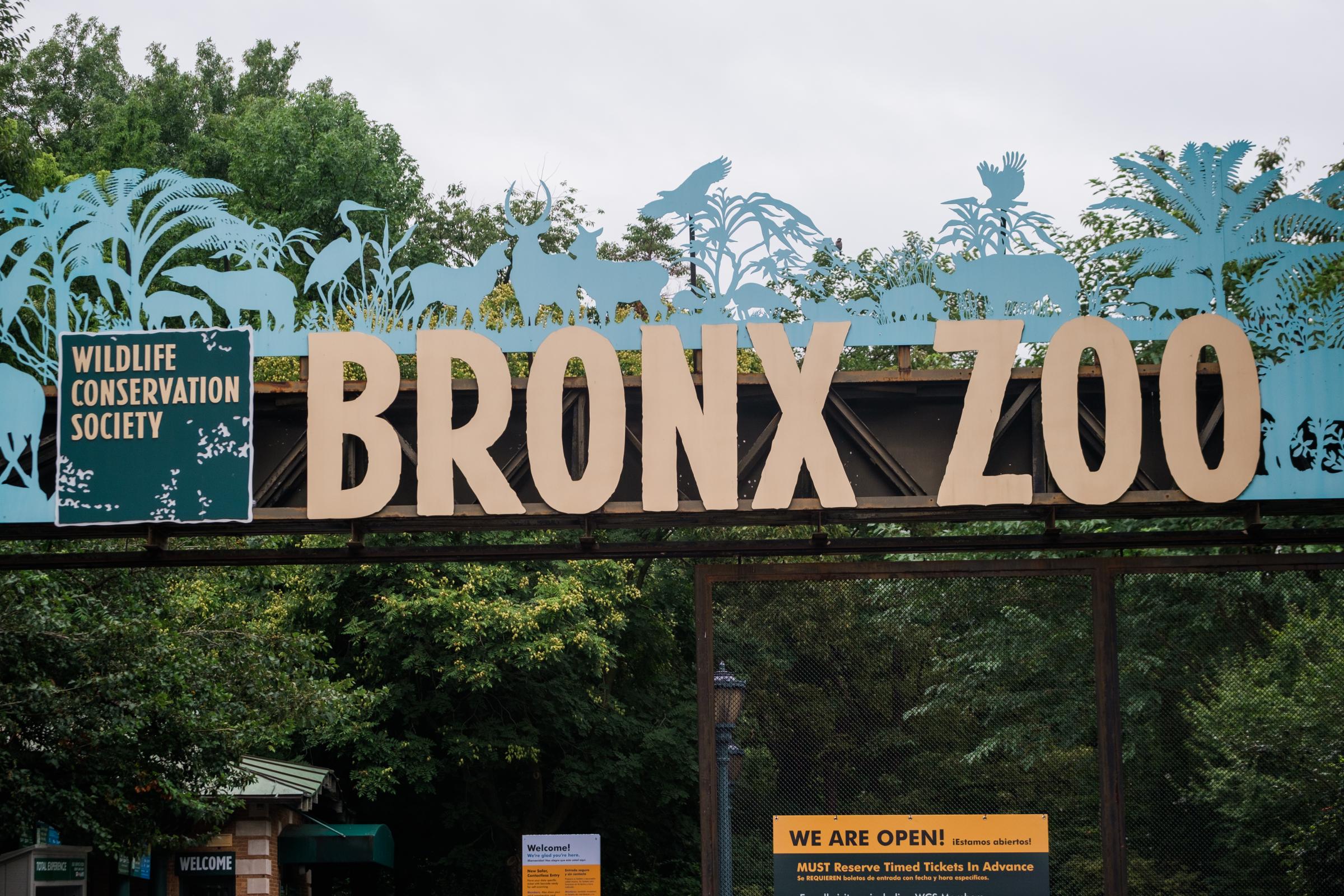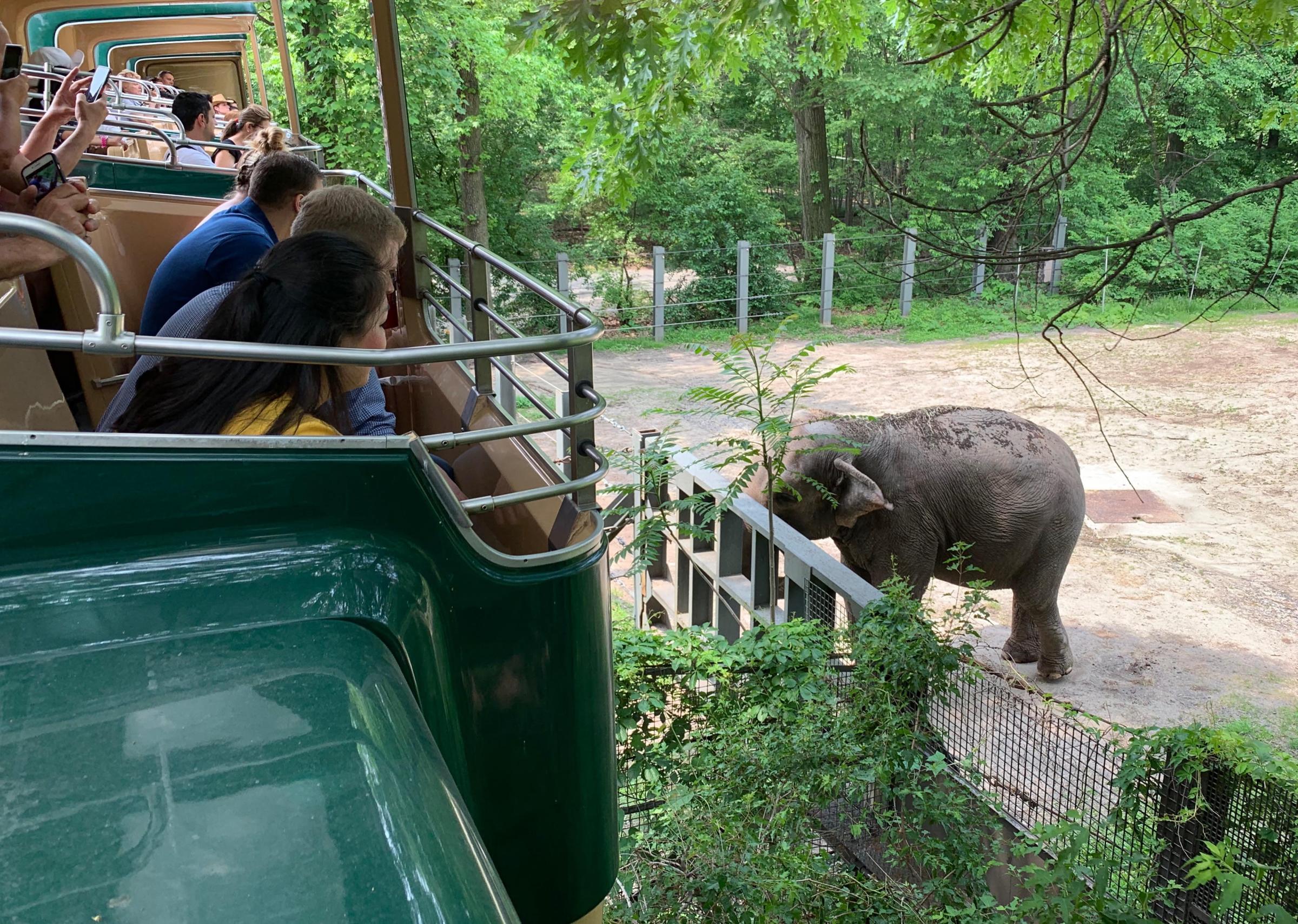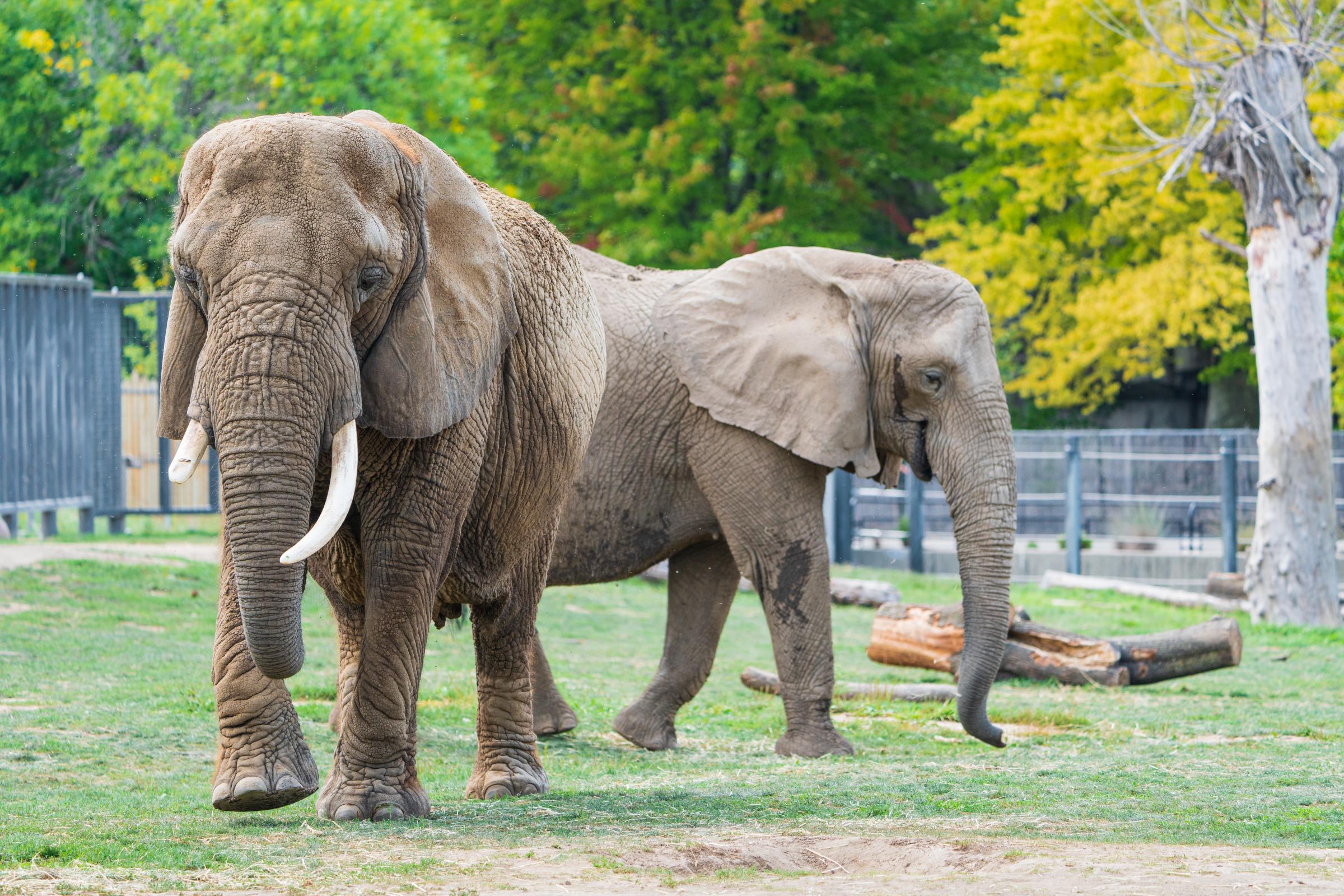
On a sunny September afternoon, Happy is standing just a few feet away from the monorail at the Bronx Zoo. Her ears flap as she wraps her trunk around a fence that separates her from the slow-moving train. There are no other barriers between them, not even plexiglass, so it’s no wonder why a child screeches in delight as the 51-year-old female Asian elephant comes into view.
This is the only place in New York City and just one of roughly 57 accredited zoos in the U.S. where you can see an elephant. And with only about an estimated 50,000 Asian elephants left in the wild, according to conservationists, the chance of seeing the endangered species at all dwindles each year it faces poaching and other threats.
But for plaintiffs in a landmark legal case to free Happy, there’s no marvel to be found below the monorail; there’s only misery to witness the half-life of an elephant—specifically one who has indicated to researchers that she’s self-aware. An online petition shows that more than 1.4 million people believe Happy is languishing in isolation at the zoo, where she’s gawked at from May through October for the $40 price of adult admission with unlimited rides.
“It’s kind of like looking at a prisoner, and you get to ride over someone who’s in solitary confinement,” says Steven Wise, president of the Nonhuman Rights Project (NhRP), the animal-rights group leading the lawsuit. “We understand what her life means to her, which is almost nothing at all.”
Against the Bronx Zoo’s wishes, the NhRP wants to move Happy to an elephant sanctuary either in Tennessee or California, where there’s more space and opportunity to socialize. To do that, the activists are relying on the writ of habeas corpus, a legal protection for imprisoned people. In 2022, the New York Court of Appeals, the highest court in the state, will hear the first argument ever made in the nation that such protections should be extended to an animal.

In 2014, the Supreme Court of India made waves in the animal rights world when it said that animals have protected rights under the nation’s constitution. As it banned a bull-fighting festival, the court said animals have the right to “live in a healthy and clean atmosphere” and “not to be beaten.” That same year, a court in Argentina reportedly ruled in a habeas corpus case that an orangutan named Sandra could be freed from a Buenos Aires zoo and moved to a sanctuary. Even though the ruling was later reversed, Sandra was still moved to a U.S. sanctuary.
Experts say Happy’s case is larger than any one pachyderm. If the NhRP is victorious, it says it would seek to end all elephant exhibits in zoos across the country, believing their efforts would save the complex creatures from stunted lives in captivity. But zoo leaders warn that such a move would have dire consequences for new generations of children and for the future of conservation, as climate change wipes more species off the planet.
“There would be a huge void to fill,” says Jodi Gibson, president of the Zoological Society of Milwaukee, who still remembers the “overwhelming excitement” she felt seeing the Milwaukee County Zoo’s elephants for the first time when she was 6. “For me, as a child, it opened a door,” she says. “Our greatest hope is for people to want to protect and preserve these beautiful animals.”
In September, the U.S. Fish and Wildlife Service declared extinct 23 species, including the ivory-billed woodpecker, and warned that climate change and habitat loss could push more species to the brink. Numerous studies and surveys have shown that children are spending more time behind screens and less time outdoors, meaning moments to connect with animals is an “increasing rarity,” says Dan Ashe, the president of the Association of Zoos and Aquariums (AZA), the main accrediting body for U.S. wildlife associations. Yet pre-pandemic, more than 200 million people visited AZA-accredited zoos annually, including more than 55 million schoolchildren, according to the AZA. Ashe says zoos have a reach that no other entity in the conservation world has, and that they teach children to care about animals without having to travel far.
Read more: Climate Change Could Wipe Out Half of All Forest Wildlife
The top experts in the world say elephants help one another regularly, indicating a capacity for empathy, and have been observed grieving. In the wilds of Kenya, elephant researcher Joyce Poole says she watched as one refused to leave the body of her stillborn calf for two days. The mother’s ears and head hung low and her eyes were downcast as she stood vigil, occasionally prodding and trying to lift the dead infant. “I saw on her face what looked like grief to me,” says Poole, who has studied the species since 1975.
Our greatest hope is for people to want to protect and preserve these beautiful animals.
In 2005, Happy showed researchers that she had one more characteristic that long seemed limited to humans and apes. She was the first Asian elephant to pass a mirror test, commonly used by scientists to gauge self-awareness through an animal’s ability to recognize itself. That’s one of the main reasons the NhRP launched a legal battle on her behalf in 2018. But it hasn’t been easy to persuade a court to grant an elephant human rights. When the case reached the Bronx County Supreme Court in 2020, the court said it was “extremely sympathetic to Happy’s plight” but that it was bound by legal precedent to find that Happy is not a person and not being illegally imprisoned. An appellate court later that year also denied habeas corpus relief to Happy. The NhRP appealed to the state’s highest court, which agreed to hear the case.

While it’s difficult to fully trace Happy’s history, the NhRP believes she was a baby when she was snatched from her family in Asia in the early 1970s and brought to the U.S. with several other calves—all named after Snow White’s dwarves. Since 1977, when the monorail first opened, Happy has been at the Bronx Zoo, where she lives on an estimated one-to-two-acre corral split between her and another female Asian elephant named Patty. The zoo declined to comment but has previously said that the two are separated by a fence because they’ve had issues getting along. In its most recent statement in 2020, the zoo said Happy is “not languishing” and that she’s well cared for by professionals. By saying she has “contact with another elephant,” the zoo disputed claims that Happy is kept in isolation.
But the NhRP and elephant experts say contact through a fence isn’t enough to fulfill social needs, and that the elephants’ lives at the zoo don’t come close to the ones they’re capable of having. In the wild, elephants can roam 30 miles each day with their families, Poole says. They’re animated, constantly touching and interacting with the families they’re born into, and autonomous. At the zoo, Happy mostly just stands in place, according to Wise, who visits monthly when the monorail is open and who receives video updates from supporters. Experts say that’s stereotypical behavior for elephants in captivity.
“When you try and take an elephant and put it behind bars in an urban setting, it’s just a recipe for disaster,” Poole says. “As you can imagine if you were locked behind bars, there’s not much to do.”
Science has come a long way since the first modern zoo opened in London’s Regent’s Park in 1828. We now understand that animals have awareness and, depending on the species, emotions and intuitiveness. Crows, jays and other corvids fashion tools from paper clips to fetch food. Octopuses, with their central nervous systems and brains distributed across eight limbs, have managed cunning escapes from their tanks. In the last century, dogs have gone from being working animals to companions and family members, prompting some states to change their laws to consider a pet’s well-being in divorce cases.
Read more: Pets Are Part of Our Families. Now They’re Part of Our Divorces, Too
When it comes to elephants, researchers now know they thrive best when they have social bonds and the challenge of finding their own food. A 2016 study published in the journal PLOS One suggested elephants tend to have impaired mental states and do not carry out basic functions like reproduction when they lose those incentives. In 2011, the AZA approved a new standard that required accredited U.S. zoos with elephants to ensure there’s room for three of them. At the time, the Bronx Zoo had three elephants and was in compliance, according to the AZA. The group said the zoo is still in compliance today. Many other zoos weren’t and couldn’t afford costly upgrades. Since 2011, at least 11 AZA-accredited U.S. zoos have ended their elephant exhibits. The vast majority of those facilities transferred their elephants to sanctuaries or bigger zoos, and at least two zoos phased out their exhibits after their resident elephants had died.
Others like the Milwaukee County Zoo poured $16.6 million into massive expansions. In their new quarters, which opened in 2019, the zoo’s three African elephants—Brittany, Ruth and Belle—have a watering hole big enough to fully themselves submerge in, a self-activating shower, a recreation room with sand and padded floors and hay-filled barrels hanging from the ceiling, among other amenities. Gibson says it was crucial to evolve the exhibit, not just for the elephants but for the tens of thousands of toddlers and teenagers, particularly those who come from low-income families, who participate in the zoo’s free and educational conservation program.
“The opportunity to witness firsthand the animals that we have here is critically important because not everyone can go on a safari and have that experience out in the wild,” she says. “It’s not just reading it in a book.”

Ashe, the AZA president, agrees, saying modern zoos are more relevant today than ever. If there are no more elephants at zoos, Ashe says, future generations of children would grow up with no connection to them, and many chances to transform sparks of interest into lifelong careers in conservation would be lost. “It’ll come at great cost,” Ashe says.
For the last few years, the U.S. Department of Agriculture—tasked with conducting unannounced inspections of all registered zoos—has not documented any egregious violations at the Bronx Zoo, according to a review by TIME of all publicly available routine inspection reports from 2014 to 2019. In that timeframe, the inspector only noted peeling walls in the mouse deer and fruit bat enclosures, some rust in the lion’s den, a water drainage issue in the babirusa’s space and overdue water-quality tests in the sea lions’ pool. In the last seven years, complaints that warranted specific welfare checks were about the zoo’s cheetahs in 2020 and the giraffes and lions in 2019. The complaints are unclear—and the Bronx Zoo did not comment—but the inspector did not find anything out of compliance during either check.
Read More: The Future of Zoos
Wise says that doesn’t mean there’s nothing wrong. And popular culture in the last few years has shown that the paradigms are continuing to shift. That’s what partially inspired SeaWorld to end its staple killer-whale shows in 2016, the company said at the time. The announcement came after the 2013 release of the documentary Blackfish, which was critical of SeaWorld for keeping killer whales in captivity. The revelations in the film quickly devastated attendance at its parks and prompted many to rethink whether such facilities have the animals’ best interest at heart. Most recently, after allegations against the Columbus Zoo and Aquarium came to light in a documentary, the AZA stripped the facility of its accreditation on Oct. 6, citing alleged financial mismanagement and claims that the zoo repeatedly transferred baby animals, mostly big cats, with vendors for entertainment purposes. The zoo said it plans to appeal.
“It’s really obvious from an ethical and moral point of view that we should not, for the purpose of money, stick animals behind bars so we can go and see them,” says Canadian conservationist Reno Sommerhalder. “It’s just not right.”

Critics, including the Bronx Zoo, say trying to use habeas corpus protections for an animal demeans the people who have sought such relief. The writ is the last chance many prisoners have to challenge the constitutionality of their convictions or sentences, and it has vindicated tens of thousands of unlawfully detained humans, says John Blume, a Cornell Law School professor who has represented prisoners in eight habeas corpus cases decided by the U.S. Supreme Court and roughly 75 habeas cases in lower courts.
“It’s been one of the primary means over the last 500 years for people to challenge the legality of their continued detention,” Blume says.
But it’s also been used in novel ways to bring about social change that seemed unlikely hundreds of years ago, including the freeing of slaves, according to six habeas corpus practitioners and scholars who submitted amicus briefs to the New York appeals court in support of the NhRP. The experts say Happy, while not a human being, is a being who has emotions and cognition and is confined and believed to be suffering. “It is because of the intense and concrete suffering associated with unjust imprisonment that habeas corpus developed in the first place,” they wrote. “If unjustly confined elephants suffer in the way a human would, the same remedy should protect elephants, too.”
For humans, habeas corpus is viewed as an extraordinary remedy, meaning people do not routinely prevail, says Blume, who has no ties to Happy’s case. From 2005 and 2009, out of roughly 917 habeas corpus decisions issued by federal appeals courts that did not involve the death penalty, 154 petitioners were granted relief, according to an analysis by Blume and other Cornell scholars. Half of the habeas corpus cases that Blume argued in front of the Supreme Court were successful.
But there’s no precedent in the U.S. for how an animal might fare, and Happy’s legal advocates say there’s not much time left to find out. Asian elephants have a lifespan of about 60 to 70 years in the wild, and in captivity, it’s considerably shorter. At 51, the NhRP says, Happy is already older than all of the seven elephants who have died at the Bronx Zoo since she arrived.
More Must-Reads From TIME
- The 100 Most Influential People of 2024
- Coco Gauff Is Playing for Herself Now
- Scenes From Pro-Palestinian Encampments Across U.S. Universities
- 6 Compliments That Land Every Time
- If You're Dating Right Now , You're Brave: Column
- The AI That Could Heal a Divided Internet
- Fallout Is a Brilliant Model for the Future of Video Game Adaptations
- Want Weekly Recs on What to Watch, Read, and More? Sign Up for Worth Your Time
Contact us at letters@time.com